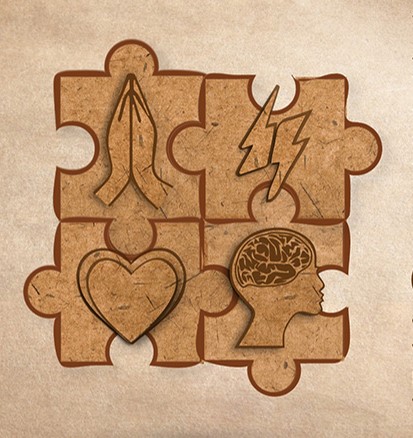Yoga, derived from “yuj”, is a Sanskrit word. Yuj means to form a union, balance or connection. A Yogi practices yoga. Thus, the entire philosophy of yoga focuses on the union and connection between the body, mind and soul.
Yoga aims to enter a state of calm and peace for a prolonged uninterrupted moment; ultimately attaining liberation. As you begin to learn yoga, you’ll realise this truth as you walk the path.
Yoga builds its foundation on four paths, each leading to the same goal of freedom. From the smallest organisms to the exceptional human life, everything around us is on the path to becoming a free spirit. Insects and animals are running towards freedom from the cycle of the food chain, humans are struggling to attain freedom from oppression and mother nature wishes for freedom from exploitation.

Breaking down the four paths of Yoga:
1. Raja Yoga
The word Raja means “King” and Raja Yoga is often used to mean “The Royal Path” towards freedom. It regulates the flow of emotions and control over the mind and body.
Raja Yoga is the integration of all yoga types, making it the king of all practices in these four paths of yoga. It is commonly known as Ashtanga Yoga or The Eight Limbs of Yoga.
Ways to practice or incorporate Raja Yoga in your daily life are:
- Yamas (Don’t): Non-violence, non-stealing, truthfulness, non-possessiveness, and self-restraint.
- Niyama (Do’s): Cleanliness, contentment, austerity, self-study, and surrender to God.
- Asana: Body alignment.
- Pranayama: Breath control.
- Pratyahara: Withdrawal of senses.
- Dharana: One-thought concentration.
- Dhyana: Meditation.
- Samadhi: Spiritual Liberation.
2. Karma Yoga

The word Karma comes from the Sanskrit word Kri which means “To do” or a form of an “action”. Hence, karma roughly translates to “the effects of all actions”.
Karma Yoga explains how one can attain the goal of freedom through actions, and more specifically work.
Essentially, people work because that is all they know. The work is done without attachments either to the consequences of their actions or the fruits they receive from them. In fact, the Yogi pays no attention to who they are helping, viewing every form of life as an equal. They work for the sake of the work and not for the sake of who it is affecting. In effect, work and duty is their true nature and they are not motivated beyond that.
An individual who can work for days, hours, or even mere minutes without attachment or judgement, without hope or wishes, has the ability to become a Karma Yogi. It is this individual who knows self-restraint to be more powerful than possession of thoughts or objects.
A Karma Yogi makes a powerful moral being.
Some ways to practice or incorporate Karma Yoga in your daily life are:
- Start the day by setting an intention for yourself. Our intentions are the beginning of any action and thus, responsible for the consequences we face.
- Set daily goals for yourself. We often try to overload our plates and lose focus of our priorities. In order to avoid that, setting daily goals helps us to step up the ladder one rung at a time.
- Every day, make a list of situations or people you want to express your gratitude to. The ability to appreciate our lives as is, helps us grow out of the pattern of hopelessness and continuous judgement. In effect, a Karma Yogi completes all tasks with thankfulness.
3. Bhakti Yoga
For a Yogi filled with love, follow the path of Bhakti Yoga. This path focuses on devotion towards God.
They see God as their love, tangible and one who listens to them just as God feels for them. The love they have for God is without any motive, without judgement, without thinking about the liberation of their soul and without regard to materialistic objects. Love in this form is pure and whole.
A Bhakti Yogi includes many rituals in her practices, from blessing their food by Him to singing songs of love.
So strong is the devotion, that they have no desire for attachments. They are content and they attain Spiritual Liberation.
Some ways to practice or incorporate Bhakti Yoga in your daily life are:
- Each day, accept everything that touches you in some way. Flow with life one day at a time, accepting all situations completely. Surrender yourself and your self-expectation to your faith.
- Wish well to all around you without judgement and attachment.
- Pay it forward to society by following the path of your desire.
- Practise chanting and singing mantras or songs that help you connect with your faith. The use of our voices is the best way to express ourselves and build a connection. Using our voice to chant spiritual mantras can be a deeply enlightening experience.
4. Jnana Yoga

Jnana Yoga grows with the roots of knowledge. Beings seek happiness and pleasure but the highest goal is that of knowledge. Ultimately, without knowledge, pleasure and happiness come to an end.
This branch of the four paths of yoga says God is present in all of us; worshipping the self is worshipping the soul and vice-versa. In the end, everything else will eventually fade away as God remains.
The Jnana Yogi is a philosopher who wants to go beyond the tangible and material nature of the world. In truth, they were to be completely infused by practical knowledge of what is beyond.
A Jnana Yogi studies various philosophies, and scriptures, undergoes training and practices meditation. Here, the intention is to use the mind to look beyond the mind. Yogis here also use elements of Bhakti Yoga, to understand the practice of devotion to God.
Some ways to practice or incorporate Jnana yoga in your daily life are:
- Learn to understand different perspectives or viewpoints in different situations you encounter in your daily life. Use your knowledge and awareness to differentiate between the real and unreal, ethical or unethical and temporary or permanent. An ability to understand and appreciate different perspectives makes room for acceptance in your life.
- Learn to detach from worldly possessions one day at a time.
- Try to set your ego aside as you learn about how the universe functions around you.
Ready to walk your path?
None of the four paths of yoga conflict with each other. As such, they are practised individually and can be integrated closely to help achieve the universal goal; freedom. This freedom we speak of is not a freedom that creates another bond for the soul but liberates it; the freedom that leads to everlasting peace and abundance of bliss.
This freedom is either through work, psychological changes, love or knowledge.
“ To the worker, it is union between men and the whole of humanity; to the mystic, between his lower and higher self; to the lover, union between himself and the God of love; and to the philosopher, it is the union of all existence”.
Swami Vivekanada
Reference books: The works of Swami Vivekanada Volume 1



